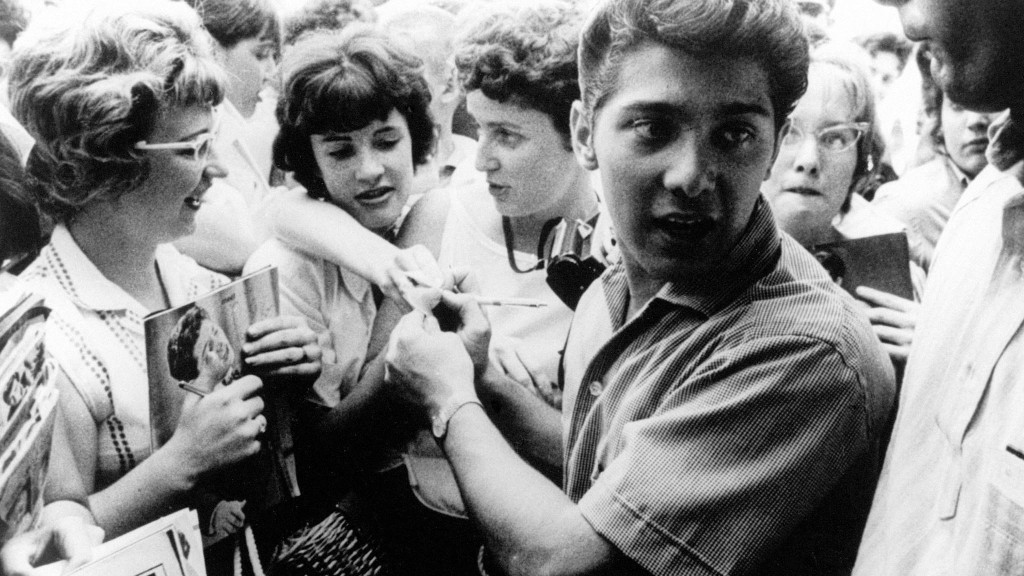Wolf Koenig and Roman Kroiter’s Lonely Boy—an ostensibly “behind-the-scenes” National Film Board (NFB) documentary short about Canadian pop star Paul Anka—is an illuminating example of Canada’s groundbreaking documentary practices of the late 1950s that is still refreshingly enjoyable a half-century later. The film, made by the NFB’s infamous Unit B, presents Anka’s charisma as a veneer for his underlying vanity and phoniness with unmistakable irony and cynicism, and yet the NFB’s packaging of the film remains a textbook example of whitewashing PR spin: “Taking a candid look at both sides of the footlights, this film examines the marketing machine behind a generation of pop singers. Interviews with Anka and his manager reveal their perspective on the industry.”
The perspectives in question are undoubtedly revealing insofar as they unsheathe an unhealthy preoccupation with Anka’s physical appearance and its importance in selling Anka as a pop idol. “After I got in the business I made up my mind that one of the things that you gotta have or you’re going to go this far [gestures short ‘ceiling’] and you’re gonna stop there, is, you gotta have appeal, and you gotta look like you’re in show business. Because if you don’t you’re not going to make it,” he rapidly explains. His manager Irvin Feld also discusses Anka’s appearance (“his eyes are great, he has a great mouth, and it is no secret we had a plastic surgery job on his nose”), tellingly before describing how he’s been able to grow Anka’s career. Feld explains with palpable pride how people think Anka’s old pictures are of a different person. Looks are high maintenance, but also long-term maintenance. This also, apparently, includes Anka’s hair, which he describes several times in unintentionally comical fashion, gesturing wildly about his head as he says “this went down, this went up, and this came up.”
According to the documentary, Anka went from “obscurity in Ottawa” to American stardom, and was one of the youngest singers to perform the American night club circuit. In 1962, the fresh-scrubbed 19-year-old had a career ahead of him. In a live performance of “Anka’s Away,” he sings about his hopes that fans will continue to love him in years to come, even when he’ll “be in my twenties with my hair turning grey.” Of course, the inclusion of these lyrics is unintentionally ironic, given that in the following decades Anka’s career was markedly less glamorous. Anka’s charisma, mentioned by the scores of young women screaming for his attention in the documentary, was not enough to maintain career longevity as a performer. Though Anka did continue to release albums, he found more success writing songs for other famous singers, including Tommy Jones’ “She’s a Lady” and Frank Sinatra’s “My Way.”
Lonely Boy hints at the constructed image of a pop singer in somewhat subtle, but noticeable ways: he gussies himself up before a mirror that reflects back at the camera, the viewer is shown a billboard of his face before the singer graces the camera with his presence, and there is of course a hilarious scene in which Anka gives the Copacabana night club owner a special gift: a portrait of Anka himself, for the office.
Lonely Boy may excel in its commentary by keeping its ironic touches mostly slight, and also in self-effacing the film’s own construction (the directors are frequently heard off-screen and filming equipment is briefly seen onscreen). There is also, naturally, the novelty direct cinema offered in the early 1960s. In 1962, when the film was made, there were no Michael Moores, no Inconvenient Truths, and not an iota of criticism against the successful Canadian singer-songwriter. The documentary mode had only recently moved out of its post-war position as a tool for state propaganda, and direct cinema seemed like the appropriate cynical response for a post-industrial society that included the absurd teen idol craze that was Anka-Mania. During a couple of scenes in the film, Anka’s performance is drowned out (on purpose) by the screams of the teenage crowd, their shrieks ghoulishly highlighted for effect. Today’s equivalent would perhaps be the YouTube meme technique in which a clip’s sound is slowed down for comic effect, but in 1962 it was rare to come across a documentary that manipulated not only images but sound to such great effect.
Lonely Boy exemplifies the distinct character of Canadian direct cinema: while American direct cinema directors aimed to capture the true “self” of their subjects, which was more likely to happen in private realms, many of their Canadian counterparts (particularly those belonging to the Candid-Eye movement, which included Lonely Boy) came to understand the power of mobility granted by new 16mm camera and portable sound equipment as a means of capturing the social construction of the public world. Lonely Boy did not seek to show the “true” Paul Anka behind the scenes because that would have been an impossible task. Instead, the film attempts (and for the most part, succeeds) in depicting the manufactured reality and artificiality of show business, and the degree to which its members, including Anka, have wholly embraced such qualities.
Watch Lonely Boy for free on the NFB website.

